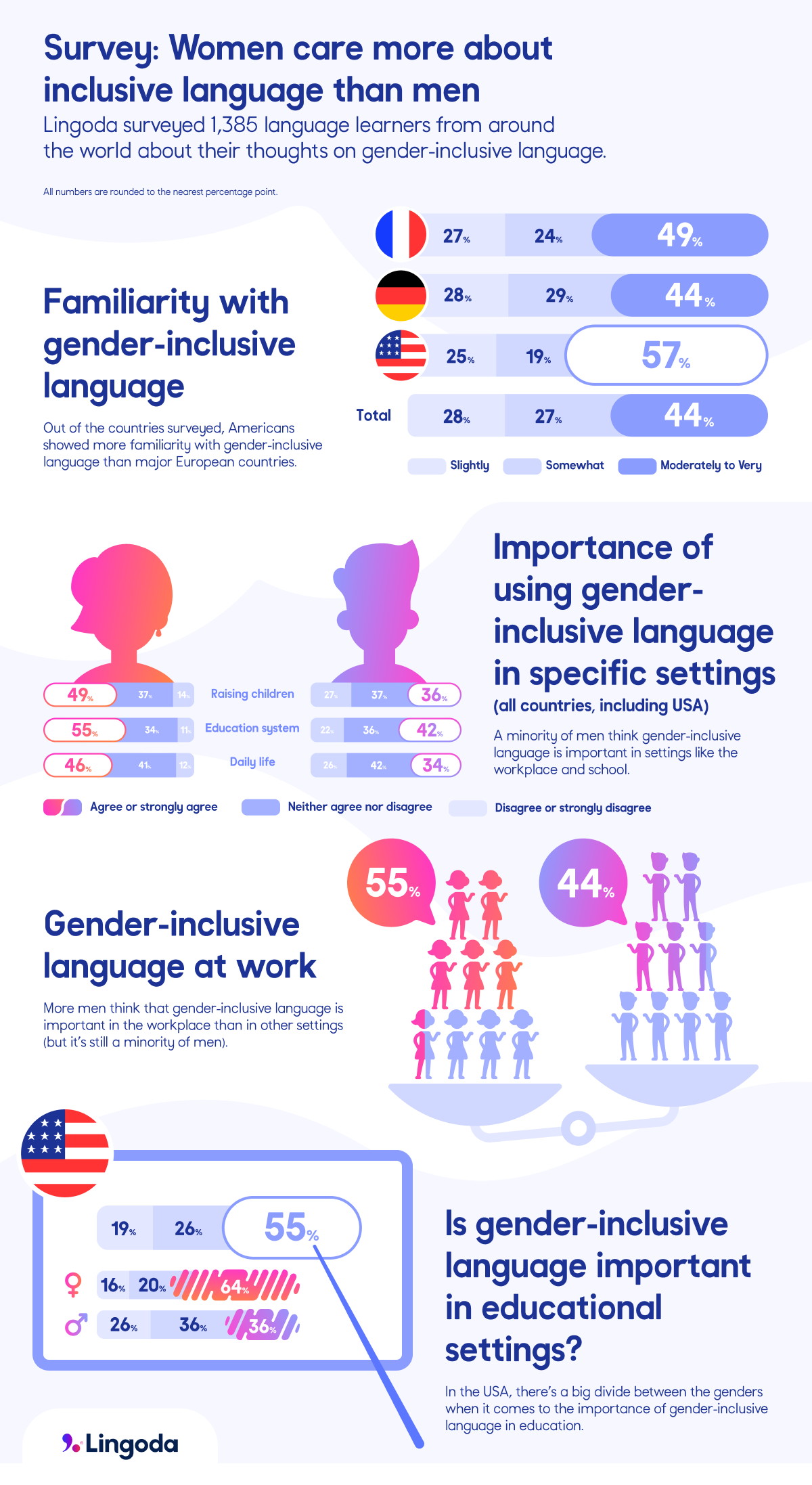
Thanks for subscribing!
Check your inbox and confirm your email address to receive offers and updates.
Written by: Lingoda Content Team
Published on: Apr 5th, 2022
Women are overall more familiar with gender-inclusive language than men and place greater importance on it, in some aspects with significant difference, a Lingoda survey among language learners finds.
The awareness of gender-inclusive language and the importance placed upon its use overall, and in various aspects of life, vary not only by gender but also by country.
The online language learning platform Lingoda surveyed over 1,300 students and found that students from the USA were most familiar with gender-inclusive language: 57% of respondents said they were moderately or very familiar with it, while Germany and France only reached 44% and 49%, respectively.
A drill-down into various aspects of life revealed that survey respondents from the US were the most likely to agree or even strongly agree on the importance of gender-inclusive language in daily and professional life, and within the education system. Only with regard to raising children were respondents in Germany slightly ahead: 48% ranked it as important, compared to the 45% of US study participants.
Read on about the gender split between those polled, the importance of gender-inclusive language in the education system and the workplace and tips on inclusive usage.
| Students from the USA are more familiar with gender-inclusive language: 57% of them reported moderate or high familiarity. Of all respondents, only 44% reported that level of awareness, compared to 49% of students in France and 44% of students in Germany. |
| In the workplace, the importance of using inclusive language rose for men, though women still placed greater importance on the matter with a difference of 11 percentage points: 55% of all female respondents compared to 44% of all male respondents stated use of inclusive language in their professional life was important to them. |
| 55% of US-American respondents consider gender-inclusive language in the education system important. However, while 64% of women agree with this, only 36% of men do. |
| Learners of German are more likely to consider gender-inclusive language important than students learning other languages: 30% of them said learning inclusive language was very or extremely important to them, compared to 26% of learners of Spanish, 23% of learners of Business English and 22% of English and French, respectively. Overall, 26% of all respondents considered learning inclusive language as important. |
Nearly half of the female survey respondents at 47% reported being very or at least moderately familiar with gender-inclusive language, while men trailed behind at 41%.
Of all survey respondents, 30% of women and 24% of men reported always or often using gender-inclusive language when speaking or writing in their first language. In the break-down of various aspects of life, women were more likely to agree or strongly agree that gender-inclusive language was important.
Science points to the reasons for this: researchers state that language can shape power dynamics in society. Used consciously or not, gendered language can be linguistic sexism that leads to and cultivates prejudice.
Gender-neutral or gender-fair language can reduce bias, stereotyping and discrimination, studies show. Linguistic asymmetry and binary word choices tend to strongly favor and benefit males, which also explains why men and women differ in their perception of gender bias: women are aware of gender inequality to a greater degree.
More inclusive language is an attempt to break up the way we encode gender in language, replace masculine generics and gender-specific pronouns and increase visibility for a non-binary or spectrum perception of gender.
The English language has gender-neutral articles and many gender-unspecific nouns. Yet in many cases, English favors the male gender, for example, with the use of generic pronouns, honorifics and job titles, as well as naming conventions or practices concerning streets, buildings or weather phenomena.
The German word Gendern describes the practice of making the language less biased, for example through the use of binary markers when referring to people or substituting gendered nouns with gender-neutral ones. The plural for students, for example, can include both the male and female, as in StudentInnen, Student*innen or Student_innen (marked but still binary) or use the neutral substitute Studierende.
The Spanish language has a pronounced binary gender split, which strongly favors the male side. The plural for friend (amigo, amiga) automatically becomes the masculine amigos even when that group is diverse, while amigas refers to a female group only. Marker solutions exist in Spanish as well: latin@s, latinEs, latinX.
Similarly, in French, the masculine plural rules over the female and male is the “default gender”. Parallel to German, nouns for professions have gender variants: un acteur, une actrice (actor, actress). French grammar has on as a gender-neutral pronoun of limited use, similar to the English one. There are attempts at establishing iel (il + elle = iel) as a neutral pronoun, combined with “dotting” adjectives for inclusivity, for example Iel est intelligent·e meaning “They are clever.”
In addition, in many languages, the female version of a noun in particular can carry a negative or sexist connotation, making it “less-than” the male counterpart. While living languages can change and biased words such as guys can lose their gendered connotation, opponents of inclusive language argue that no language can become fully gender-neutral.
The drill-down into the data from US language learners reveals that 55% of respondents in the USA agree that gender-inclusive language is important in the education system, e.g. at school, in college and in academia. Similarly, 55% placed importance on inclusive language at work and 51% in everyday life, whereas only 45% viewed it as important when raising children.
Regarding inclusive language in the education system, especially younger people viewed it as important: 61% of participants up to 30 years of age agreed, compared to 54% of 31-45-year-olds and 48% of 46+-year-olds.
Discussions and media coverage of gender neutrality policies in the US, especially in schools and public institutions, often centers on the legislated use of restrooms. Courts have been hearing discrimination cases in the past when faculty, staff or students were denied to use the bathroom of their choice, sometimes even when it corresponded to the gender on their driver’s license.
This varies across states: North Carolina’s Public Facilities Privacy & Security Act from 2016 required accordance with the sex of people’s birth certificate, but was repealed in December 2020, while California enacted a law in 2013 giving students the right to use the bathroom of their gender identity.
Language use in US schools and education is likewise a contested issue: the Florida senate recently approved a measure dubbed the ‘Don’t say gay’ bill which would prohibit school discussions related to sexual orientation and gender identity. However, research shows that students, especially when they belong to the LGBTQ+ community, achieve greater academic success and experience a better school climate when they attend education institutions with an inclusive curriculum.
On the upside, positive examples of gender-inclusive language in education show a trend toward gender-neutral pronouns at colleges. Vanderbilt University, Harvard University and the University of California have pushed for gender-neutral pronouns during registration, for class rosters or housing assignments. The University of Oklahoma dropped the traditional homecoming “king and queen” in favor of “homecoming royalty”, thus joining others of the Big 12 universities.
Teachers can use non-biased, gender-neutral language to make the classroom a more inclusive space. There are a couple of tips on things to consider and practice:
In the US, Both men and women find gender-inclusive language more important in the workplace than in daily life. 62% of female and 42% of male study participants in the USA placed importance on the issue. Especially younger participants viewed inclusive-language as important:
A survey shows that 75% of organizations report diversity and inclusion programs as a value or priority. However, nearly 80% of employees state they’re not aware of efforts toward a more inclusive culture. All demographics report barriers to feeling included, foremost among them LGBTQ+ respondents, minorities, and women.
An inclusive and equitable work environment can benefit organizations through increasing and retaining diversity in their workforce. Diversity and inclusion programs attract applicants and enable better performance. Perceived inclusion can lead to employees feeling three times more committed to their job and company.
This has a positive effect on the bottom line as well: the top 25% of gender diverse companies are 15% more likely to outperform the median financial returns for their sector.
We’ve compiled a brief guide with several tips for how human resources, management and employees in your organization can implement diversity and inclusion for a more productive, comfortable and welcoming work environment.
The benefit of learning about diversity and inclusion issues when studying a foreign language is that you compare these to your first language and automatically become more aware of bias, unfairness, or stereotypes you might not have questioned before. “Inclusive language is important to us at Lingoda. We want all learners to feel represented in our materials. We also know that being able to master inclusive and gender-neutral language is an increasingly essential communicative competence for second-language learners. Our new learning materials use and teach inclusive and gender-neutral language and we’re working to establish this as the standard in every Lingoda class.” Philippa Wentzel, Curriculum Team Lead.
As outlined above, gender-biased language tends to favor or benefit a particular gender, that is males. Even though other genders stand to gain from more inclusivity, we shouldn’t think of gender-neutral language as a zero-sum-game in which the loss of privilege puts one side at a disadvantage. On the contrary, less discrimination and more fairness in language enable everyone to communicate with more openness and vulnerability, hopefully leading to more understanding also.

For this study, Lingoda collected quantitative data from 1,385 language learners on the platform. All students had a currently active Lingoda account and could opt into the survey through the My classes, lesson detail screen and class log part of their user area. Over the period of Nov 29, 2021, to Dec 3, 2021, participants answered questions regarding the familiarity with gender-inclusive language, the importance they placed upon it overall as well as in different aspects of life, and their use of gender-inclusive language when speaking their native language. Of a total of 1,385 respondents, 400 were based in Germany, 199 in the USA, 74 in France and 712 from other countries.